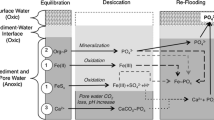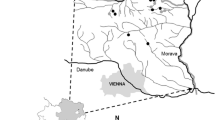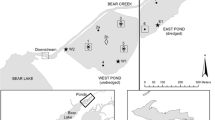Abstract
Wetland restoration provides many benefits, but re-flooding historically drained land can have unintended negative consequences, including phosphorus (P) release from sediments. To investigate the effects of re-flooding on P cycling, this study monitored a restoration in Michigan that back-flooded old drainage ditches and re-flooded former wetland soils. Immediately after re-flooding, previously exposed sediments released substantial amounts of P to the water column. Soluble reactive phosphorus (SRP) concentrations in re-flooded areas were as high as 750 μg P l−1. At peak P concentrations, there were about 20 times more SRP and 14 times more total P in the surface water than in the much smaller flooded area that existed before re-flooding. Prolific growth of filamentous algae and duckweed was observed in subsequent summers. Sedimental analyses suggest that most of the P released originated from iron-bound fractions. The highest SRP concentrations occurred during the first year when surface water dissolved oxygen was low (<5.5 mg l−1). Similarly low oxygen in the second year after flooding was not associated with such high P concentrations. After 1 year postflooding, SRP concentrations remained below 50 μg P l−1 (but still high enough to produce eutrophic conditions) until the end of sampling about 15 months after re-flooding. When re-flooding historically drained soils, managers should consider the potential for sediment P release to jeopardize restoration goals and therefore should incorporate longer term monitoring of water quality into restoration plans. Knowledge of sediment P amounts and forms can indicate the potential for P release to overlying water.





Similar content being viewed by others
References
Aldous A, McCormick P, Ferguson C, Graham S, Craft C. 2005. Hydrologic regime controls soil phosphorus fluxes in restoration and undisturbed wetlands. Restor Ecol 13:341–7.
Aldous AR, Craft CB, Stevens CJ, Barry MJ, Bach LB. 2007. Soil phosphorus release from a restoration wetland, Upper Klamath Lake, Oregon. Wetlands 27:1025–35.
Allen HE, Fu G, Boothman W, DiToro DM, Mahoney JD. 1991. Determination of acid volatile sulfides (AVS) and simultaneously extracted metals in sediment. Draft analytical method for determination of acid volatile sulfide in sediment. Washington, DC: U.S. Environmental Protection Agency.
Aminot A, Kirkwood DS, Kérouel R. 1997. Determination of ammonia in seawater by the indophenol-blue method: evaluation of the ICES NUTS I/C 5 questionnaire. Mar Chem 56:59–75.
Andersen JM. 1976. An ignition method for determination of total phosphorus in lake sediments. Water Res 10:329–31.
Ardón M, Montanari S, Morse JL, Doyle MW, Bernhardt ES. 2010a. Phosphorus export from a restored wetland ecosystem in response to natural and experimental hydrologic fluctuations. J Geophys Res 115:1–12.
Ardón MJL, Morse MW Doyle, Bernhardt ES. 2010b. The water quality consequences of restoring wetland hydrology to a large agricultural watershed in the southeastern coastal plain. Ecosystems 13:1060–78.
Axt JR, Walbridge MR. 1999. Phosphate removal capacity of palustrine forested wetlands and adjacent uplands in Virginia. Soil Sci Soc Am J 63:1019–31.
Baldwin DS, Mitchell AM, Rees GN. 2000. The effects of in situ drying on sediment–phosphate interactions in sediments from an old wetland. Hydrobiologia 431:3–12.
Bostic EM, White JR. 2007. Soil phosphorus and vegetation influence on wetland phosphorus release after simulated drought. Soil Sci Soc Am J 71:238–44.
Boström B, Andersen JM, Fleischer S, Jansson M. 1988. Exchange of phosphorus across the sediment–water interface. Hydrobiologia 170:229–44.
Corstanje R, Reddy KR. 2004. Response of biogeochemical indicators to a drawdown and subsequent reflood. J Environ Qual 33:2357–66.
Coveney MF, Stites DL, Lowe EF, Battoe LE, Conrow R. 2002. Nutrient removal from eutrophic lake water by wetland filtration. Ecol Eng 19:141–59.
Dahl TE. 1990. Wetland losses in the United States 1780s to 1980s. Washington, D.C., Jamestown, ND. http://www.npwrc.usgs.gov/resource/wetlands/wetloss/index.htm.
Duff JH, Carpenter KD, Snyder DT, Lee KK, Avanzino RJ, Triska FJ. 2009. Phosphorus and nitrogen legacy in a restoration wetland, Upper Klamath Lake, Oregon. Wetlands 29:735–46.
Gerke J. 2010. Humic (organic matter)–Al(Fe)–phosphate complexes: an underestimated phosphate form in soils and source of plant-available phosphate. Soil Sci 175:417–25.
Geurts JJM, Smolders AJP, Verhoeven JTA, Roelofs JGM, Lamers LPM. 2008. Sediment Fe:PO4 ratio as a diagnostic and prognostic tool for the restoration of macrophyte biodiversity in fen waters. Freshw Biol 53:2101–16.
Golterman H, Clymo R. 1969. Methods for chemical analysis of fresh waters. Oxford: Blackwell.
Grasshoff K, Ehrhardt M, Kremling K, Eds. 1983. Methods of seawater analysis. Weinheim: Verlag Chemie.
Hamilton SK. 2012. Biogeochemical time lags may delay responses of streams to ecological restoration. Freshw Biol 57(Suppl. 1):43–57.
Hansson L-A, Bronmark C, Anders Nilsson P, Abjornsson K. 2005. Conflicting demands on wetland ecosystem services: nutrient retention, biodiversity or both? Freshw Biol 50:705–14.
Jensen HS, Kristensen P, Jeppesen E, Skytthe A. 1992. Iron:phosphorus ratio in surface sediment as an indicator of phosphate release from aerobic sediments in shallow lakes. Hydrobiologia 235(236):731–43.
Kinsman-Costello LE. 2012. Effects of water level fluctuations on phosphorus, iron, sulfur, and nitrogen cycling in shallow freshwater ecosystems. Doctoral Dissertation, Department of Zoology, Michigan State University.
Langerveld J. 2009. Using partnership and low cost structure to successfully restore wetland on a military base in Michigan. Master’s Thesis, Department of Geography, Western Michigan University.
Loeb R, Lamers LPM, Roelofs JGM. 2008. Effects of winter versus summer flooding and subsequent desiccation on soil chemistry in a riverine hay meadow. Geoderma 145:84–90.
Lovley DR, Phillips EJP. 1987. Rapid assay for microbially reducible ferric iron in aquatic sediments. Appl Environ Microbiol 53:1536–40.
Lucassen ECHET, Smolders AJP, Roelofs JGM. 2005. Effects of temporary desiccation on the mobility of phosphorus and metals in sulphur-rich fens: differential responses of sediments and consequences for water table management. Wetlands Ecol Manag 13:135–48.
MacDonald GK, Bennett EM, Taranu ZE. 2012. The influence of time, soil characteristics, and land-use history on soil phosphorus legacies: a global meta-analysis. Glob Change Biol 18:1904–17.
Marsden MW. 1989. Lake restoration by reducing external phosphorus loading: the influence of sediment phosphorus release. Freshw Biol 21:139–62.
Martin HW, Ivanoff DB, Graetz DA, Reddy KR. 1997. Water table effects on histosol drainage water carbon, nitrogen, and phosphorus. J Environ Qual 26:1062–71.
McLatchey GP, Reddy KR. 1998. Regulation of organic matter decomposition and nutrient release in a wetland soil. J Environ Qual 27:1268–74.
McLaughlin JR, Ryden JC, Syers JK. 1981. Sorption of inorganic phosphate by iron- and aluminum-containing components. J Soil Sci 32:365–77.
Mitchell AM, Baldwin DS. 1998. Effects of desiccation/oxidation on the potential for bacterially mediated P release from sediments. Limnol Oceanogr 43:481–7.
Montgomery JA, Eames JM. 2008. Prairie Wolf Slough Wetlands Demonstration Project: A case study illustrating the need for incorporating soil and water quality assessment in wetland restoration planning, design and monitoring. Restor Ecol 16:618–28.
Murphy J, Riley JP. 1962. A modified single solution method for the determination of phosphate in natural waters. Anal Chim Acta 27:31–6.
Newman S, Pietro K. 2001. Phosphorus storage and release in response to flooding: implications for Everglades stormwater treatment areas. Ecol Eng 18:23–38.
Niedermeier A, Robinson JS. 2009. Phosphorus dynamics in the ditch system of a restored peat wetland. Agric Ecosyst Environ 131:161–9.
Olila OG, Reddy KR, Stites DL. 1997. Influence of draining on soil phosphorus forms and distribution in a constructed wetland. Ecol Eng 9:157–69.
Paludan C, Jensen HS. 1995. Sequential extraction of phosphorus in freshwater wetland and lake sediment: Significance of humic acids. Wetlands 15:365–73.
Pant HK, Reddy KR. 2003. Potential internal loading of phosphorus in a wetland constructed in agricultural land. Water Res 37:965–72.
R Development Core Team. 2011. R: A language and environment for statistical computing. Vienna: R Foundation for Statistical Computing.
Reddy KR, DeLaune RD. 2008. Biogeochemistry of wetlands. Boca Raton: CRC Press.
Reitzel K, Ahlgren J, Gogoll A, Jensen HS, Rydin E. 2006. Characterization of phosphorus in sequential extracts from lake sediments using P-31 nuclear magnetic resonance spectroscopy. Can J Fish Aquat Sci 63:1686–99.
Schönbrunner IM, Preiner S, Hein T. 2012. Impact of drying and re-flooding of sediment on phosphorus dynamics of river-floodplain systems. Sci Total Environ 432:329–37.
Smolders AJP, Moonen M, Zwaga K, Lucassen ECHET, Lamers LPM, Roelofs JGM. 2006. Changes in pore water chemistry of desiccating freshwater sediments with different sulphur contents. Geoderma 132:372–83.
Soil Survey Staff, Natural Resources Conservation Service, and United States Department of Agriculture. 2012. Web soil survey. http://websoilsurvey.nrcs.usda.gov/. Accessed 9 April 2012.
Steinman AD, Ogdahl ME. 2011. Does converting agricultural fields to wetlands retain or release P? J N Am Benthol Soc 30:820–30.
Stookey LL. 1970. Ferrozine—a new spectrophotometric reagent for iron. Anal Chem 42:779–81.
USDA-FSA Aerial Photography Field Office. 2006. naip_1-1_2n_mi077_2006_1 Version1. Utah: Salt Lake City.
Verhoeven JTA, Arheimer B, Yin C, Hefting MM. 2006. Regional and global concerns over wetlands and water quality. Trends Ecol Evol 21:96–103.
Walbridge MR, Richardson CJ, Swank WT. 1991. Vertical distribution of biological and geochemical phosphorus subcycles in two southern Appalachian forest soils. Biogeochemistry 13:16–85.
Wetzel RG, Likens GE. 2000. Limnological analyses. 3rd edn. New York: Springer.
Whitmire SL, Hamilton SK. 2005. Rapid removal of nitrate and sulfate in freshwater wetland sediments. J Environ Qual 34:2062–71.
Wong SW, Barry MJ, Aldous AR, Rudd NT, Hendrixson HA, Doehring CM. 2011. Nutrient release from a recently flooded delta wetland: comparison of field measurements to laboratory results. Wetlands 31:433–43.
Young EO, Ross DS. 2001. Phosphate release from seasonally flooded soils: a laboratory microcosm study. J Environ Qual 30:91–101.
Zak D, Wagner C, Payer B, Augustin J, Gelbrecht J. 2010. Phosphorus mobilization in rewetted fens: the effect of altered peat properties and implications for their restoration. Ecol Appl 20:1336–49.
Zedler JB. 2003. Wetlands at your service: reducing impacts of agriculture at the watershed scale. Front Ecol Environ 1:65–72.
Acknowledgments
The authors are grateful to Jim Langerveld and the Environmental Office at the Fort Custer Training Center for providing site access and logistic support, as well as to Henning S. Jensen and colleagues at the University of Southern Denmark for valuable advice on phosphorus sequential extraction techniques. Thanks are due to David Weed, Jen Pham, Laura Podzikowski, David Kinsman, Steve Robbins, Brandon Kovnat, Rob Davis, Paige Howell, and Megan Lowenberg for support in lab and the field. Allen Burton and his lab at the University of Michigan provided protocols and logistic support for measuring acid-volatile sulfides in sediments. Early drafts of this article were improved by comments from Alan Steinman, Jay Lennon, R. Jan Stevenson, and two anonymous reviewers. This research was funded by NSF DEB Grants 0743402, 0423627, 0910008, and 1027253.
Author information
Authors and Affiliations
Corresponding author
Additional information
Author Contributions
LEK-C: helped design the study, performed research, analyzed data, and wrote the manuscript; JOB: helped design the study, performed research, and provided extensive revisions to the manuscript; SKH: conceived of and helped design the study and provided extensive revisions to the manuscript.
Electronic supplementary material
Below is the link to the electronic supplementary material.
Rights and permissions
About this article
Cite this article
Kinsman-Costello, L.E., O’Brien, J. & Hamilton, S.K. Re-flooding a Historically Drained Wetland Leads to Rapid Sediment Phosphorus Release. Ecosystems 17, 641–656 (2014). https://doi.org/10.1007/s10021-014-9748-6
Received:
Accepted:
Published:
Issue Date:
DOI: https://doi.org/10.1007/s10021-014-9748-6




